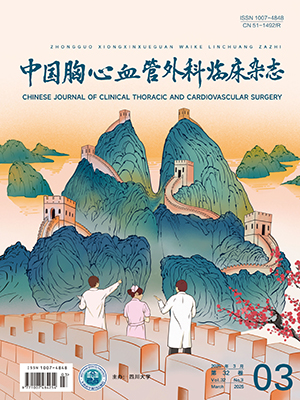| 1. |
Pan F, Li J, Lou H, et al. Geographical and socioeconomic factors influence the birth prevalence of congenital heart disease: A population-based cross-sectional study in Eastern China. Curr Probl Cardiol, 2022, 47(11): 101341.
|
| 2. |
van der Linde D, Konings EE, Slager MA, et al. Birth prevalence of congenital heart disease worldwide: A systematic review and meta-analysis. J Am Coll Cardiol, 2011, 58(21): 2241-2247.
|
| 3. |
Sehgal A, McNamara PJ. International perspective on management of a patent ductus arteriosus: Lessons learned. Semin Fetal Neonatal Med, 2018, 23(4): 278-284.
|
| 4. |
Ku L, Cheng Y, Ma X. Infectious endarteritis associated with patent ductus arteriosus and vegetation: A challenging diagnosis and treatment. Eur Heart J, 2022, 43(23): 2251.
|
| 5. |
国家卫生健康委员会国家结构性心脏病介入质量控制中心, 国家心血管病中心结构性心脏病介入质量控制中心, 中华医学会心血管病学分会先心病经皮介入治疗指南工作组, 等. 常见先天性心脏病经皮介入治疗指南(2021版). 中华医学杂志, 2021, 101(38): 3054-3076.National Health Commission National Structural Heart Disease Intervention Quality Control Center, National Cardiovascular Disease Center Structural Heart Disease Intervention Quality Control Center, Chinese Medical Association Cardiovascular Disease Branch Congenital Heart Disease Percutaneous Intervention Treatment Guidelines Working Group, et al. Common congenital heart disease percutaneous intervention treatment guidelines (2021 edition). Nat Med J China, 2021, 101(38): 3054-3076.
|
| 6. |
Baumgartner H, De Backer J, Babu-Narayan SV, et al. 2020 ESC guidelines for the management of adult congenital heart disease. Eur Heart J, 2021, 42(6): 563-645.
|
| 7. |
Yarboro MT, Gopal SH, Su RL, et al. Mouse models of patent ductus arteriosus (PDA) and their relevance for human PDA. Dev Dyn, 2022, 251(3): 424-443.
|
| 8. |
袁运杰, 秦永文, 汤敬东, 等. 应用自体血管制作的犬动脉导管未闭模型. 介入放射学杂志, 2006, 15(9): 552-554.Yuan YJ, Qin YW, Tang JD, et al. The preparation of patent ductus arteriosus model in dog by using self-vessel. J Interv Radiol, 2006, 15(9): 552-554.
|
| 9. |
李俊杰, 曾国洪, 张智伟, 等. 一种国产动脉导管未闭堵闭器的动物试验评价. 中华心血管病杂志, 2001, 29(10): 622-625.Li JJ, Zeng GH, Zhang ZW, et al. Experimental evaluation of a homemade patent ductus arteriosus closure device. Chin J Cardiol, 2001, 29(10): 622-625.
|
| 10. |
Pozza CH, Gomes MR, Qian Z, et al. Transcatheter occlusion of patent ductus arteriosus using a newly developed self-expanding device. Evaluation in a canine model. Invest Radiol, 1995, 30(2): 104-109.
|
| 11. |
Sharafuddin MJ, Gu X, Titus JL, et al. Experimental evaluation of a new self-expanding patent ductus arteriosus occluder in a canine model. J Vasc Interv Radiol, 1996, 7(6): 877-887.
|
| 12. |
Grabitz RG, Freudenthal F, Sigler M, et al. Double-helix coil for occlusion of large patent ductus arteriosus: Evaluation in a chronic lamb model. J Am Coll Cardiol, 1998, 31(3): 677-683.
|
| 13. |
Sigler M, Handt S, Seghaye MC, et al. Evaluation of in vivo biocompatibility of different devices for interventional closure of the patent ductus arteriosus in an animal model. Heart, 2000, 83(5): 570-573.
|
| 14. |
Jiang HB, Bai Y, Zong GJ, et al. Pan-nitinol occluder and special delivery device for closure of patent ductus arteriosus: A canine-model feasibility study. Tex Heart Inst J, 2013, 40(1): 30-33.
|
| 15. |
Chen L, Hu S, Luo Z, et al. First-in-human experience with a novel fully bioabsorbable occluder for ventricular septal defect. JACC Cardiovasc Interv, 2020, 13(9): 1139-1141.
|
| 16. |
张凤文, 孙毅, 谢涌泉, 等. 完全可降解封堵器治疗膜周部室间隔缺损两例. 中国胸心血管外科临床杂志, 2018, 25(7): 636-638.Zhang FW, Sun Y, Xie YQ, et al. Perimembranous ventricular septal defect treated with a completely biodegradable occluder: Two cases report. Chin J Clin Thorac Cardiovasc Surg, 2018, 25(7): 636-638.
|
| 17. |
Kong P, Zhao G, Zhang Z, et al. Novel panna guide wire facilitates percutaneous and nonfluoroscopic procedure for atrial septal defect closure: A randomized controlled trial. Circ Cardiovasc Interv, 2020, 13(9): e009281.
|
| 18. |
Pan XB, Ou-Yang WB, Pang KJ, et al. Percutaneous closure of atrial septal defects under transthoracic echocardiography guidance without fluoroscopy or intubation in children. J Interv Cardiol, 2015, 28(4): 390-395.
|
| 19. |
Wen B, Peng R, Kong P, et al. Neuroblastoma suppressor of tumorigenicity 1 mediates endothelial-to-mesenchymal transition in pulmonary arterial hypertension related to congenital heart disease. Am J Respir Cell Mol Biol, 2022, 67(6): 666-679.
|
| 20. |
Duport O, Le Rolle V, Guerrero G, et al. Sensitivity analysis of a cardio-respiratory model in preterm newborns for the study of patent ductus arteriosus. Annu Int Conf IEEE Eng Med Biol Soc, 2021, 2021: 4420-4423.
|




